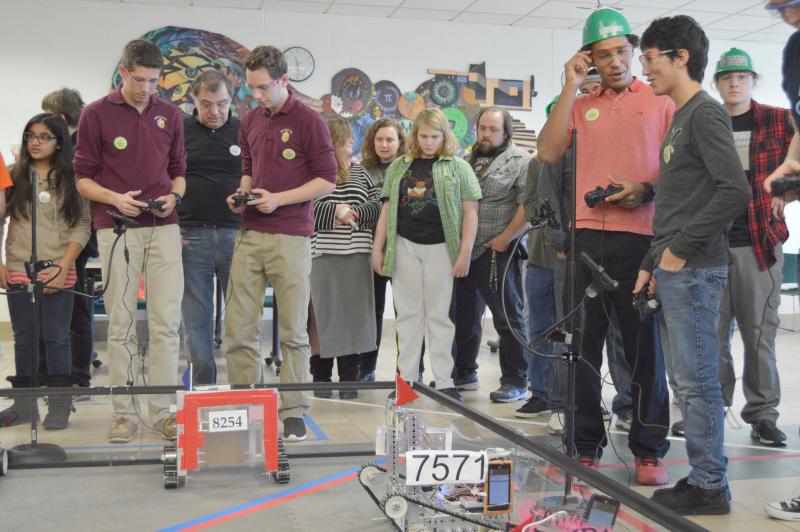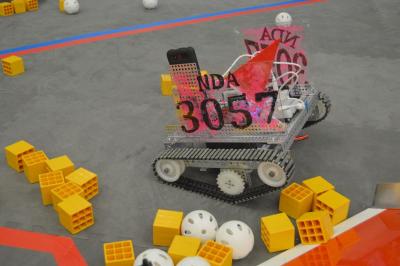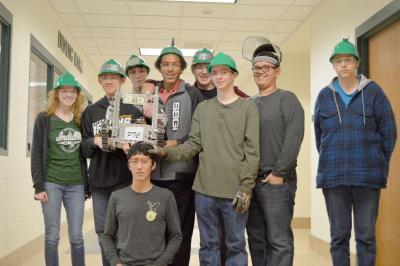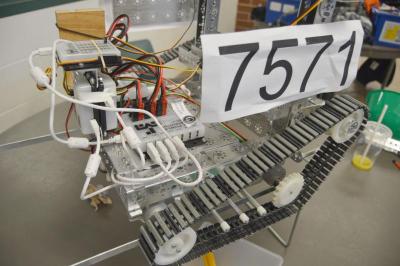Robots show off their fine motor skills at FIRST Tech Challenge
Robots from around the region battled for supremacy in the Dartmouth High cafeteria, completing challenges with the help of their human creators.
The FIRST (For Inspiration and Recognition of Science and Technology) Tech Challenge tasks students with building robots and setting their metal machines through a series of challenges. The league-style tournament will be going on throughout the area, eventually culminating in a state championship. The first match was on Nov. 21 in Dartmouth.
The theme and challenges change year to year. This year’s course was designed after mountain rescue situations. The robots had to be able to move around debris by pushing blocks into a goal area or placing them in buckets on the side on the “mountain” – an elevated portion of the course.
“The robots have a thirty-second period where they have to be autonomous, and there’s a two-minute period where they’re allowed to be remote controlled,” said Dartmouth High engineering teacher Samuel Brodsky. “During that time, there are a number of ways to score.”
A portion of the cafeteria floor became the pit for robots to compete. Kids and spectators surrounded and cheered as robots attempted to move blocks onto goals as quickly as possible. During the matches, some robots fared better than others. A few teams had malfunctions early on and couldn’t prompt their robots to move forward.
Back in September, the teams were given a Tetrix kit, which contains the pieces needed to assemble the machine.
“You’re allowed to use anything in the kit. You can also add to it. There are rules governing the use of large motors, projectiles, complicated assemblies,” said Brodsky.
Teams spent time between matches to tinker with their robots in preparation for the next contest.
Ashley Vieira, 16, a junior who led the 9-person Dartmouth High team, said this year’s competition wasn’t her first robot rodeo.
“We were a rookie team last year, and it was kind of tough starting off. Eventually, we learned to communicate, and this year I feel more confident in our team,” said Vieira. “Our robots a lot better it than it was last year, too.”
Her group spent about two weeks assembling the robot. She said the biggest challenge of piecing together a robot was working with her fellow humans.
“Everyone was doing their own thing, but that didn’t work out because no one knew what our whole goal was,” she said. “A few week ago, we sat down and organized what our goals for the robot were and worked on them.”
Matt Duggan, 17, and Justin Peak, 18, both seniors at Bishop Stang, were the only two from their team of eight who could attend the event. Oddly, Duggan, who was there to pilot the robot for his missing teammates, had some initial hesitation when it came to engineering.
“I have a lot of friends in the robotics program and they peer-pressured me into joining it. I didn’t know how much I’d like it, but it turned out to be a lot of fun,” he said.
Bishop Stang has made it to the state level of the competition twice. Duggan echoed the sentiments of the Dartmouth team.
“Learning how to collaborate with your peers makes a functioning robot,” said Duggan. “It’s a skill you can take with you in life.”
Brodsky said that robot competitions have a broad appeal and tend to bring together different kinds of students, both academically and socially.
“This is an authentic engineering experience,” said Brodsky. “You’re given a problem. You have to come up with a design. You have to troubleshoot your design, and you’re doing that in a cooperative environment with a team. When the team doesn’t work together, nothing happens.”
All the teams will participate in two more meets followed by a championship round in February. The scores from all four matches will be added together to determine the overall winner. The next meet will be on Dec. 19.






















